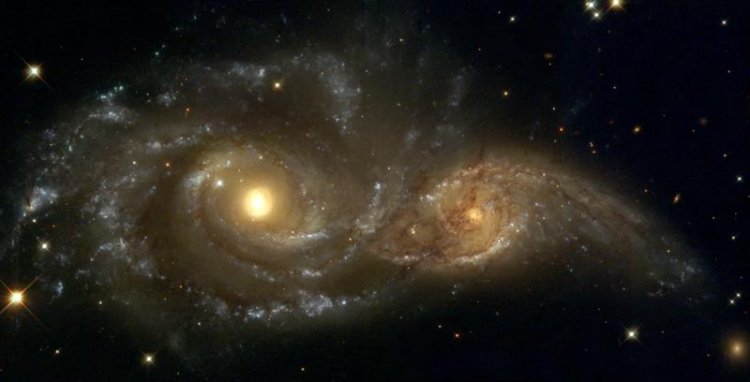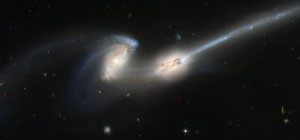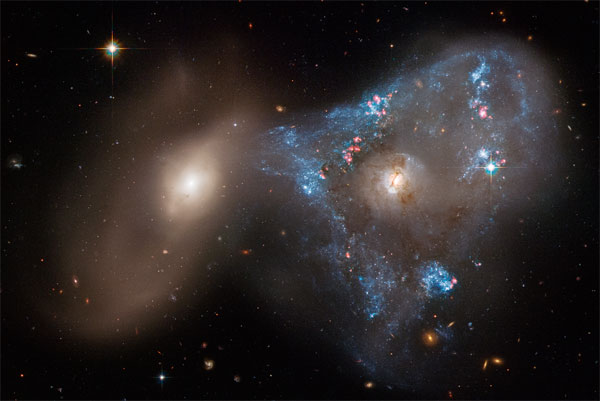galaxy interaction

Figure 1. Grazing encounter between the spiral galaxies NGC 2207 and IC2163.

Figure 2. The Mice (NGC4676), and the extraordinary long tidal tail extending from one of the galaxies. Credit: NASA, H. Ford (JHU), G. Illingworth (UCSC/LO), M.Clampin (STScI), G. Hartig (STScI), the ACS Science Team, and ESA.

Figure 3. A spectacular head-on collision between two galaxies fueled thel triangular-shaped star-birthing frenzy, captured in this image from the Hubble Space Telescope. The interacting duo is known collectively as Arp 143. The pair contains the distorted, star-forming spiral NGC 2445 at right, along with its companion, NGC 2444. Astronomers suggest that the galaxies passed through each other, igniting the star-formation firestorm in NGC 2445, where thousands of stars are bursting to life. This galaxy is awash in starbirth because it is rich in gas. However, it hasn't yet escaped the gravitational clutches of its partner, on the left of the image. The pair is waging a cosmic tug-of-war, which NGC 2444 appears to be winning. The galaxy has pulled gas from NGC 2445, forming the oddball triangle of newly minted stars.
Galaxy interaction is an encounter between two (or more) galaxies that is close enough for the mutual gravitational attraction to alter the appearance and, in some cases, the composition, of one or both systems (Fig 1). Classic examples include NGC 5195, the little, tidally distorted companion of the Whirlpool Galaxy, and the Antennae. Extreme cases of interaction result in galaxy mergers or galaxy cannibalism.
Galaxy merger
Galaxy merger is the process that takes place when two galaxies collide with one another. If the galaxies become caught in one another's gravitational field they do not simply make a close pass, undergo galaxy interaction, and continue their separate ways into intergalactic space. Instead they spiral into one another and form a single galaxy at the end of the interaction. It is thought that giant elliptical galaxies are the products of mergers between spiral galaxies. Since the spaces between individual stars in galaxies are so large, even though the galaxies appear to collide, the stars contained within them do not. There's enough space for the two galaxies to virtually pass through one another like interlinking fingers. The huge gravitational fields of the galaxies, however, distort their shapes and the close stellar encounters swing the stars into randomly orientated orbits. Often the interstellar clouds collapse during the merger and many new stars are formed in a process called a starburst. As the galaxies become closer and closer, long tails of stars are strung out in their wake. Sometimes these tail fragments contain enough matter to be thought of as dwarf galaxies in their own right.
Tidal tail
A tidal tail is a tail-like structure of stars that has been flung out behind a galaxy when it merges with another system galaxy. Tidal tails are produced when the galaxies fall into each other's gravitational potential wells and may persist long after the merger has taken place.
The Tadpole Galaxy displays an extraordinarily long tidal tail (Fig 2). Other well known systems showing pronounced tidal tails are The Antennae and The Mice.
Galaxy cannibalism
Galaxy cannibalism is the swallowing of a smaller galaxy by a much larger one, in contrast to a galactic merger, which involves two galaxies of similar size. Most examples of cannibalism involve giant or supergiant ellipticals, at the heart of rich clusters of galaxies (those having many members within a relatively compact region of space), drawing in and ingesting other members of their fold. Tell-tale signs of a big elliptical having recently (in cosmic terms) swallowed a disk galaxy, for example, include significant amounts of dust and young stars, loops and shells of luminous matter, and various other phenomena, such as powerful radio emission, that suggests the central supermassive black hole of the swallowing galaxy has just received a fresh consignment of matter. On a less dramatic scale, dwarf galaxies are frequently cannibalized by their larger neighbors. The Sagittarius Dwarf Elliptical Galaxy, for example, is currently being devoured by the Milky Way.


